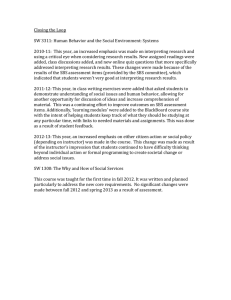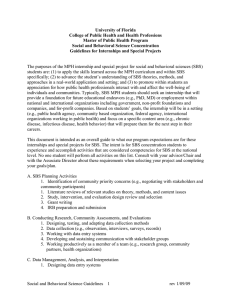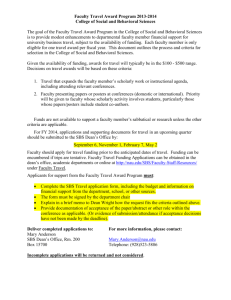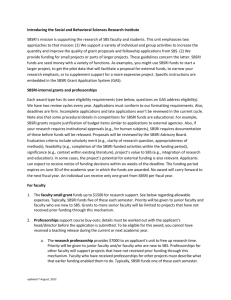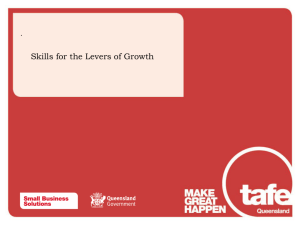6 om as a public service of the RAND Corporation.
advertisement
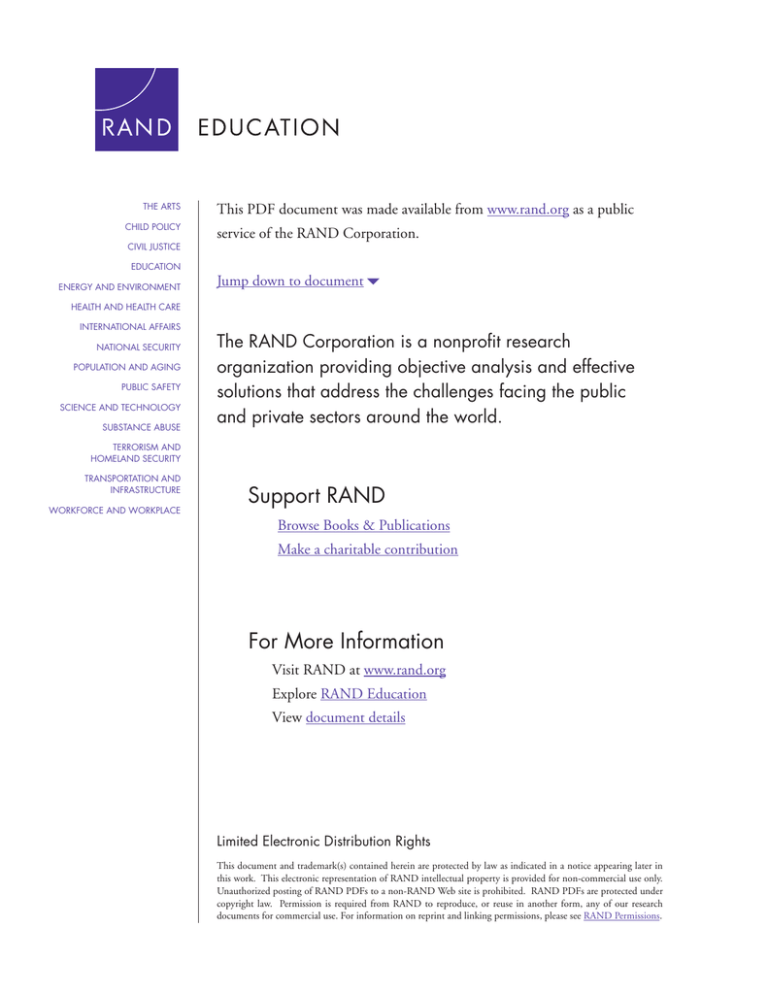
THE ARTS CHILD POLICY CIVIL JUSTICE EDUCATION ENERGY AND ENVIRONMENT This PDF document was made available from www.rand.org as a public service of the RAND Corporation. Jump down to document6 HEALTH AND HEALTH CARE INTERNATIONAL AFFAIRS NATIONAL SECURITY POPULATION AND AGING PUBLIC SAFETY SCIENCE AND TECHNOLOGY SUBSTANCE ABUSE The RAND Corporation is a nonprofit research organization providing objective analysis and effective solutions that address the challenges facing the public and private sectors around the world. TERRORISM AND HOMELAND SECURITY TRANSPORTATION AND INFRASTRUCTURE WORKFORCE AND WORKPLACE Support RAND Browse Books & Publications Make a charitable contribution For More Information Visit RAND at www.rand.org Explore RAND Education View document details Limited Electronic Distribution Rights This document and trademark(s) contained herein are protected by law as indicated in a notice appearing later in this work. This electronic representation of RAND intellectual property is provided for non-commercial use only. Unauthorized posting of RAND PDFs to a non-RAND Web site is prohibited. RAND PDFs are protected under copyright law. Permission is required from RAND to reproduce, or reuse in another form, any of our research documents for commercial use. For information on reprint and linking permissions, please see RAND Permissions. This product is part of the RAND Corporation technical report series. Reports may include research findings on a specific topic that is limited in scope; present discussions of the methodology employed in research; provide literature reviews, survey instruments, modeling exercises, guidelines for practitioners and research professionals, and supporting documentation; or deliver preliminary findings. All RAND reports undergo rigorous peer review to ensure that they meet high standards for research quality and objectivity. The Step by Step Early Childhood Education Program Assessment of Reach and Sustainability Cathleen Stasz, Cathy Krop, Afshin Rastegar, Mirka Vuollo Prepared for the Open Society Institute EDUCATION The research described in this report was prepared for the Open Society Institute and was conducted by RAND Education, a unit of the RAND Corporation. The RAND Corporation is a nonprofit research organization providing objective analysis and effective solutions that address the challenges facing the public and private sectors around the world. RAND’s publications do not necessarily reflect the opinions of its research clients and sponsors. R® is a registered trademark. © Copyright 2008 RAND Corporation All rights reserved. No part of this book may be reproduced in any form by any electronic or mechanical means (including photocopying, recording, or information storage and retrieval) without permission in writing from RAND. Published 2008 by the RAND Corporation 1776 Main Street, P.O. Box 2138, Santa Monica, CA 90407-2138 1200 South Hayes Street, Arlington, VA 22202-5050 4570 Fifth Avenue, Suite 600, Pittsburgh, PA 15213-2665 RAND URL: http://www.rand.org To order RAND documents or to obtain additional information, contact Distribution Services: Telephone: (310) 451-7002; Fax: (310) 451-6915; Email: order@rand.org - xiii - EXECUTIVE SUMMARY In 1994, the Open Society Institute (OSI) embarked on a two-year pilot project, the Step by Step (SbS) program, to introduce child-centered methodologies and family and community engagement strategies in preschools located in 15 countries in Central and Eastern Europe. The program’s core activity was to support professional development of educators (teachers, teacher assistants, teacher trainers, methodologists, administrators) and to provide resources to develop classrooms and teaching practices that would promote open and critical thinking in a new generation of children. However, both this mandate and the length of program commitment have since expanded. The SbS program was designed to be self-sustaining. OSI and its international network of Soros Foundations provided targeted start-up funding to selected preschool sites for up to five years to develop capacity in the participating countries. After that time, funds secured from the national Soros Foundations or from other sources (e.g., the United States Agency for International Development [USAID], European Union [EU], World Bank) would be needed to sustain and expand the program. OSI funding primarily focuses on special initiatives, such as inclusion of children with disabilities in mainstream education, in which some SbS programs participate, or the International Step by Step Association (ISSA) network. OSI also continues to support core operations in about one-third of the countries and provides all participating countries with funds for networking. Since its inception, the SbS program has expanded in several ways: x In reach, by being introduced to teachers in preschool and primary classrooms (up to age 10) in over 30 countries. x In substance, by developing a broader range of new ideas and practices, such as whole school improvement; inclusion of special needs children into mainstream classrooms; programs specific to Roma children and minorities; early childhood development (ECD) programs, such as parent education, which support children who do not attend preschool; and publication of developmentally appropriate children’s literature. x In sustainability, by creating non-governmental organizations (NGOs) to administer SbS and advocate for education reform, by securing official Ministry endorsement and support, by influencing existing university-based teacher-training programs, and by other means. - xiv x At the regional level, ISSA was created as a platform to sustain and enhance the focus on early years in the region. Given a significant investment in SbS (over $125 million), OSI is now assessing how to further support the program and how to promote expansion to new countries in cooperation with other donors. The OSI is searching for solid information upon which to base its decisions. OSI approached RAND to carry out an independent assessment of the reach and sustainability of the SbS program. First, RAND conducted an exploratory study using available data sources. Following that study, RAND carried out a further research and development project from October 2006 through March 2008. This report presents findings from the latter study. APPROACH, QUESTIONS, AND LIMITATIONS The project had two aims. The OSI’s main interest was to assess the SbS program’s reach and sustainability. A second aim was to work collaboratively with OSI’s Early Childhood Program (ECP) to provide technical assistance to develop an online survey to gather data about the SbS programs in each country. The ECP has carried out country surveys in the past, so the present project built on that base but extended the scope of the survey and survey analysis. We began by developing a set of indicators of program reach and sustainability, drawing from different sources, including prior SbS program surveys, indicators historically used by OSI to gauge the SbS programs, and sustainability indices used by international organizations. SbS comprises a number of initiatives, and the program’s operations are tailored to each country; therefore, the reach and sustainability of a program depend partly on its capacity. Thus, we also included indicators to assess program capacity. Finally, we incorporated some measures of efforts to change teachers’ practices, because teachers are the central focus of SbS’s core preschool and primary school initiatives. The RAND team developed two surveys (general and financial), using both the indicators and prior OSI surveys. The ECP and a task force convened for the project reviewed the indicators and survey items through several iterations. RAND also consulted with OSI on technical aspects of developing an on-line survey. The OSI/ECP had responsibility for putting the survey on-line, administering it, and data cleaning. The survey was administered in July 2007 to the 31 country directors who have responsibility for administering SbS. Responses to both surveys were - xv received from all SbS organizations except for Kazakhstan, which completed the financial survey only. This report relies mainly on these survey data to address the following broad questions: x What are the human and organizational capacities of SbS programs? x How widespread is the program’s reach in each country? How many children, teachers, and parents participate? x What are the programs’ efforts to affect teachers’ practices? What are the perceived effects of these efforts? x How sustainable is the SbS program? RAND developed and carried out a detailed data-analysis plan that expanded on these broad study questions and utilizes straightforward descriptive statistics. The OSI will carry out any future survey administration and analysis. RAND has provided detailed specifications to OSI to facilitate replication. Although most of this project’s effort was focused on survey development, it is important to recognize that the survey data cannot do justice to the breadth and uniqueness of individual SbS programs and initiatives. The SbS programs are guided by core aims, methodologies, and principles; yet, they operate in very different country contexts, and in most cases the SbS approach challenges the traditional education doctrine. There is no set formula for SbS. Indeed, for a program to take hold, develop, grow, and sustain itself over time, it must learn to adapt to the country context so that it can identify opportunities to secure funding and influence children’s education and parent and community involvement. In addition to this limitation, the study relies on self-report survey data. Survey respondents were not promised confidentiality and are known to OSI. This may have increased the likelihood of responding in ways that they thought might be more favorable to OSI and the ECP. The ECP carried out a thorough data-cleaning process, and data judged unreliable were eliminated from the analysis. However, the survey bears all the limitations of self-report data, including some unknown error. FINDINGS What Is SbS’s Capacity? Country directors reported being generally satisfied with the number and capabilities of their permanent, paid staff members and have sufficient office equipment and materials. They reported having confidence in their mission and strategic - xvi directions, and most have an actively involved Board of Directors (BoD). As expected, the countries vary quite a lot in training capacity and in the distribution of training over initiatives, a situation that, in part, reflects their need to be flexible and to operate in ways that align with country-specific conditions. In most countries, the demand for training exceeds capacity, due mainly to lack of funds to train more trainers. How Widespread Is the SbS Program’s Reach? SbS initiatives focus on multiple participants, mainly teachers and other educators, but also children, parents, communities, educational institutions, and national governments. SbS can reach these participants directly (e.g., through training, teaching) or more indirectly (e.g., distribution of books and materials, advocacy, participation in national policymaking). All countries engage in the core activity of training and mentoring for preschool and primary school educators. Survey data gathered in this study indicate the following levels of participation from September 1994 until December 2006: x 68,000 trained teachers have implemented SbS methodologies at the preschool, primary, and post-primary levels. x 600 teachers per country on average have received training in ISSA pedagogical standards. x A conservative estimate is that 1.5 million children have been exposed at least once to SbS methodologies in preschool, primary, and post-primary classrooms. x 759 individuals have received training to become parent facilitators in countries participating in parent education/community initiatives. x About 3,500 parents participated in parent education initiatives in 2006. Another indicator of program reach is distribution of printed materials. Survey data indicate that x 644 teachers per country on average have received copies of ISSA pedagogical standards since they were published in 2001. x Over 24,000 Parent Booklets have been distributed in countries since their parent programs began. x Nearly 21,000 Reading Corner books were distributed or sold in 2006 alone. These figures are certainly underestimates. The number of participating children, for example, does not take teachers’ tenures into account, because this information is unavailable. Also, parent materials are often shared among parents, and ISSA - xvii standards and other teacher-related materials are also available electronically (e.g., on SbS NGO and ISSA Web sites). SbS programs can enhance their reach by distributing provision of training to geographically dispersed training centers (23 countries utilize a network of centers), teacher-retraining institutions (ten countries), and pre-service teacher-training institutions (11 countries). Country directors reported that over 1,200 faculty at preservice institutions have been trained in SbS methodologies, which means that potentially tens of thousands of student teachers are learning SbS methodologies. The SbS program is being institutionalized into national education systems. Through such efforts as attaining Ministry of Education (MoE) endorsement of SbS methodologies and influencing national education policy, SbS potentially reaches many more individuals than those directly involved through its training activities. SbS programs have been successful in attaining MoE endorsement in their country and have been involved in developing policy, curriculum, and standards at the national level. What Are the Efforts to Affect Teachers’ Practices? SbS initiates teachers into its methodologies in a number of ways, from initial training to follow-up mentoring and certification in ISSA pedagogical standards. Professional development of teachers has always been a key component of the SbS strategy and philosophy, and the development and implementation of the ISSA pedagogical standards, and support of the ISSA network, is intended to ensure good practice. This emphasis on professional development is one of the strengths of the program. Education reforms that require changes in teachers and classrooms are notoriously difficult to implement, and teacher training is a necessary component for success. Survey data from this study indicate that maintaining a system of teacher mentoring and professional development remains a challenge for many SbS organizations. Only four of 30 countries reported that it was easy to maintain a system. Lack of financial resources was the most significant barrier, followed by a rigid curriculum in the country and lack of resources for teachers. Eighteen countries can certify teachers in ISSA pedagogical standards. One challenge here is to demonstrate that standards are a way to enhance personal professional growth through self-reflection and personal effort in countries in which it is more typical for teachers to be inspected by government authorities. - xviii Follow-up visits to teachers after basic training were not especially frequent. In a majority of countries, 25 percent or fewer trained teachers regularly received SbS journals or newsletters or invitations to more-advanced SbS training events or conferences. This is not to say that SbS organizations have not been active in their efforts to promote quality. Country directors reported carrying out a number of activities in 2006 toward this end, with meetings for mentors or trainers as the most widespread activity among SbS organizations. A majority of SbS organizations also engaged in activities to advocate for teacher standards in 2006, both within and outside the SbS network, such as incorporating ISSA pedagogical standards in all projects and arranging for non-SbS teachers to visit SbS classrooms. Country directors’ estimates of the extent to which trained teachers are implementing SbS methodologies were mixed. Although the professional-development activities enable country directors to have some knowledge of teachers’ performance, country directors’ perceptions provide only a rough measure of the effects of SbS training and development activities. At the preschool level, country directors judged that about half of trained SbS teachers were “fully implementing” SbS methodologies; this reduced to 40 percent at the primary level and 20 percent at the post-primary level. Are SbS Programs Sustainable? According to recent USAID reports, the overall picture for sustainability of the NGO sector is problematic for some of the regions of the world in which SbS organizations operate. Political and legal conditions in many countries are quite volatile, and the environment can change significantly in a short time. Some SbS organizations operate in more stable conditions than others, and the available funding opportunities also differ widely across regions. This study examined financial and non-financial sustainability by reviewing data on indicators generally accepted by international organizations to assess the NGO sector. First, the study determined that most SbS organizations face competition from organizations providing similar services, and nine countries reported that competition threatens their sustainability. Interestingly, countries facing competition that threatens their program trained more individuals on average and attracted more earned income in 2006 than countries that felt less threatened. It may be that competition creates an incentive for SbS organizations to work harder to recruit trainees or to differentiate their program from competitors’. - xix The data on non-financial indicators of sustainability paint a fairly positive picture, which bodes well for SbS organizations overall. Country directors reported the following: x Most SbS organizations can operate freely and without restriction within the law, but also reported that government authorities or other groups put pressures on them that can hamper their work. x SbS organizations take on multiple advocacy roles, either in leadership positions or in support of other groups, and a majority are involved in education policy at the national level. x SbS organizations enjoy a positive public image, locally, nationally, and internationally. In a majority of countries, SbS organizations have more demands for their services than they are able to provide. x The infrastructure for SbS organizations is generally strong, with most having established networks with non-SbS NGOs or public institutions, and sufficient organizational capacity with respect to mission, strategic planning capabilities, and BoD involvement. The evidence for financial sustainability is also generally positive: x Organizations are attracting multiple grants from diverse sources, and some countries are increasingly generating grant income through participation in large-scale national or multicountry initiatives. In total, organizations raised about $6.5 million in grant income in 2006. x There is still a relatively heavy reliance on Soros-related funding sources and international donors relative to local sources. In 2006, countries on average received 36 percent of their grant income from OSI/Soros, although this varied greatly across countries. x For the vast majority, the laws in their country do not restrict SbS organizations’ ability to attract and collect grant income, to receive funds for services, or to contract with the national or local government to provide services. x In total, organizations achieved over $1 million in earned income in 2006, from publication sales, training fees, and consulting/contracts. Most organizations are covering the costs of the services or products with the income generated from them. However, five countries had no earned income in 2006, and three generated limited earned income from only one source. Barriers to increasing earned income include an inability of potential clients - xx to pay for services and lack of trainers, resources, or facilities to offer or expand services. x Twenty SbS organizations received in-kind support amounting to over $2 million, and there may be potential to tap more support in countries that did not receive any. In considering the general picture of sustainability outlined here, it is important to remember that individual SbS organizations may face more-severe challenges to longterm sustainability than others, and, for planning purposes, individual country conditions must still be taken into consideration. RECOMMENDATIONS The study points to a number of recommendations for improving SbS program initiatives and capabilities: 1. Continue Efforts to Enhance NGO Capacity. Although country directors report confidence in their organizational health, there is scope to improve their strategic planning in such areas as teacher follow-on and support and fundraising. 2. Promote and Evaluate Efforts to Raise Teacher Quality. Efforts to promote teacher quality and professional development may need closer attention and increased investment. The study revealed some difficulties in maintaining follow-up with teachers after initial training to support them. Although SbS organizations carry out a number of activities to enhance teacher quality, there is insufficient information to link those efforts to teacher outcomes. 3. Solidify Existing Networks. Problems with teacher follow-up after initial training in 2006 raise questions about the extent of contact with teachers and others trained in earlier years. It is important for SbS to maintain its network of trained teachers and other participants who are the mainstay of SbS’s social capital. Maintaining a network of teachers, directors, and parents trained over the years helps support advocacy efforts and creates potential for adopting new initiatives within countries. SbS may want to revisit capacity and strategies for maintaining networks. 4. Consider More Investments in Systems Change. Given the difficulty in maintaining quality mentoring for individual teachers, it may make sense for SbS and ISSA to shift priorities from promoting NGO-based mentoring systems to supporting system-level changes (e.g., preschool/school directors, methodologists, and inspectors) to enhance quality program implementation. - xxi 5. Pay Attention to Financial Sustainability. Overall, SbS organizations’ financial sustainability looks positive, but more attention could be paid to generating earned income, attracting in-kind support, attracting more-local sources of funding, and developing strategies for fundraising. 6. Consider the Costs and Benefits of Improving Data Quality. Gathering systematic data still presents a challenge for some SbS organizations, and the ECP and ISSA continue to identify ways to improve data quality. However, it will always be more difficult to capture reach and participation in a system in which training is distributed rather than centralized and over which SbS has no direct control (e.g., training in preservice institutions). Efforts to improve the quality of some information, such as keeping track of teacher trainees exposed to SbS methodologies, may be costly, and these costs must be weighed against the value of the information to decisionmakers. 7. Carry Out Targeted Evaluation Studies. OSI could carry out or sponsor smallscale targeted evaluation studies, as has been done in the past with Roma initiatives and NGO sustainability. Assessing teacher quality and the relationship between quality and professional-development activities is one example. Resource trade-offs would need to be considered, because funds directed to data gathering or program evaluation may be diverted from program activities, including expansion of the SbS program to new countries.
